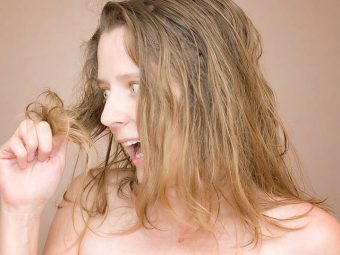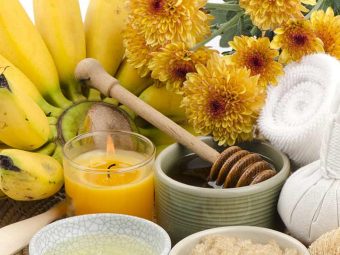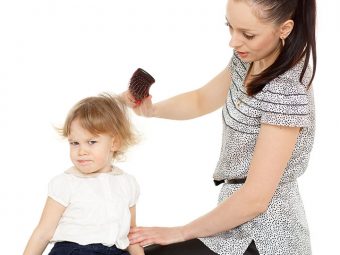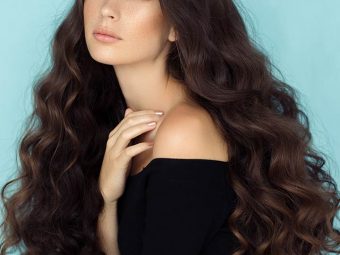DIY Hair Oils For Different Hair Problems
A list of powerful and easy-to-prepare concoctions for shiny and healthy locks.
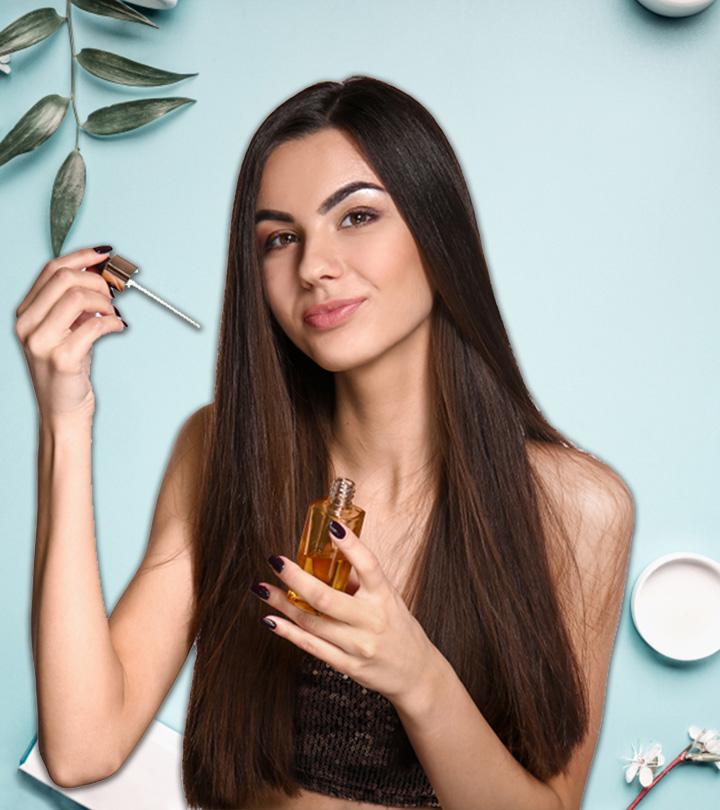
DIY hair oils can nourish your hair and combat hair fall effectively. Oiling the hair and massaging the scalp are the proven ways to reduce hair fall. This will also strengthen the hair follicle, enhance blood circulation, and give the required nourishment to the scalp. If you want to give your hair a silky look without any chemicals, these oils listed in the post below are for you. Know how these oils can help promote hair growth and get the recipes of 5 hair oils right here. Scroll down!
In This Article
Best Oils For Hair Growth
- Coconut Oil
Coconut oil is rich in saturated fats and can penetrate the hair shafts to provide deep moisturization. A study shows that coconut oil also helps reduce protein loss (1).This oil works wonders for low-porosity hair or 4C curly hair by detangling the knots. You can use virgin coconut oil for a relaxing scalp massage.
- Almond Oil
Almond oil is an emollient and has anti-inflammatory properties (2). It is lightweight and ideal for fine and straight hair. Click here for the benefits of almond oil for your hair.
- Castor Oil
Castor oil is a thick and viscous oil that is extracted from Ricinus communis plant. Anecdotal evidence suggests that castor oil can help promote hair growth and thicken your eyebrows and eyelashes. However, the viscous nature of this hair oil makes it a little difficult to apply and rinse.
Note: Dilute castor oil with another oil and use it only on your scalp.
- Hibiscus Oil
Hibiscus oil is a red-colored oil extracted from the hibiscus flowers. A study found hibiscus leaf oil to be more potent for hair growth than the one extracted from the flower (3). Hibiscus oil has been used in India since ancient times for thick and luscious locks. Moreover, it has a pleasant smell, hydrates the hair, and prevents dandruff.
- Jojoba Oil
Jojoba oil possesses anti-inflammatory properties and is widely used as a skin care ingredient (4). It also nourishes the hair and stimulates its growth. It moisturizes the hair and scalp and helps prevent split ends and breakage. Jojoba oil can also help treat dry scalp, dandruff, and itchy scalp.
- Argan Oil
Argan oil is light as a feather. It can be used for scalp massaging and styling rough, dry hair. It is composed of monounsaturated and saturated fatty acids, tocopherols, polyphenols, sterols, triterpene alcohols, and squalene (5). Argan oil helps keep the scalp healthy, prevents hair breakage, and makes the hair smooth and shiny.
Apart from these oils, essential oils are also great for hair growth and adding a beautiful, relaxing aroma to your DIY hair oil. Here’s a list of the essential oils you can use.
Best Essential Oils For Hair Growth
- Peppermint Essential Oil
A study showed that peppermint oil helped increase the number of hair follicles, hair follicle depth, and thickness in mice (6). This oil has a soothing effect on the scalp and can also help reduce dandruff.
- Lavender Essential Oil
A study confirms that lavender oil can be used for hair growth (7). Lavender oil, when applied to the scalp with a carrier oil (jojoba or grapeseed oils) can be a safe and effective therapy for alopecia areata (8).
- Rosemary Oil
Rosemary essential oil can also be used for treating androgenic alopecia or female pattern hair loss (9). It helps reduce scalp itchiness, nourishes the scalp, and stimulates the hair follicles.
- Cedarwood Oil
Cedarwood oil helps balance oil production, has antifungal and antibacterial properties, reduces hair loss, and promotes hair growth. Along with a carrier oil, cedarwood oil can also help treat alopecia areata (8).
- Chamomile Oil
Chamomile oil has relaxing effects and is good for soothing the scalp. It also helps transform rough hair into soft curls.
These essential oils are beneficial for hair growth. Now, get your wands out! We are going to prepare the magic oils for spellbinding thick hair!
5 Best DIY Hair Oil Treatment Recipes
1. Lavender And Coconut Oil For Hair Growth
You Will Need
- 1 drop of lavender essential oil
- 10 drops of coconut oil
Directions
- Mix the lavender essential oil and coconut oil. Shake well.
- Massage this oil mixture onto your scalp and hair.
- Shampoo your hair and apply argan oil.
Note: You can create a batch of this blend and store it for future use.
2. Peppermint And Almond Oil For Hair Growth
You Will Need
- 1 drop of peppermint oil
- 15 drops of almond oil
Directions
- Mix the peppermint and almond oils.
- Shake well and store in a dry place.
- Massage this oil blend onto the scalp in a circular motion.
- Leave it on for 15 minutes and wash your hair.
Note: Do a patch test before using peppermint oil. If you have a tingling effect on your scalp, avoid using it.
3. Rosemary, Argan And Castor Oil For Hair Growth
You Will Need
- 1 drop of rosemary oil
- 5 drops of castor oil
- 5 drops of argan oil
Directions
- Mix the rosemary oil, castor oil, and argan oil in a bowl.
- Stir this mixture with a glass or steel straw.
- Apply this oil blend only to the scalp to prevent hair tangles.
- Leave it on for 20 minutes and rinse.
4. Chamomile And Jojoba Oil For Hair Growth
You Will Need
- 1 drop of chamomile oil
- 10 drops of jojoba oil
Directions
- Mix the chamomile oil and jojoba oil.
- Massage this oil mixture onto the scalp and hair.
- Leave it on for 20 minutes and wash your hair.
- Cedarwood And Hibiscus Oil For Hair Growth
You Will Need
- 1 drop of cedarwood oil
- 10 drops of hibiscus oil
Directions
- Mix the cedarwood oil and hibiscus oil. Shake well.
- Massage this mixture onto the scalp and hair for 10minutes.
- Leave it on for 20 minutes and rinse.
There you have it – 5best DIY hair oils. But how do you store them? Find out in the next section.
How To Store DIY Hair Oils
Store these DIY hair oils in brown glass bottles and use a dropper. You can find them at any online store. Ensure to store them away from the sun and in a dry place. Also, create oils in batches to prevent them from going rancid.
Here’s a list of the dos and don’ts you should follow while using DIY hair oils.
Dos And Don’ts
- Do a patch test at the back of your neck to see if you are allergic to essential oils. Do not use them if you feel a burning or tingling sensation.
- Avoid using stale and rancid oils.
- Do not use essential oils directly. Always dilute them with a carrier oil.
DIY hair oils replenish your hair, improving its thickness, smoothness, and shine. Oiling your hair and massaging your scalp improve blood circulation and stimulate hair follicles. Carrier oils like coconut, almond, castor, hibiscus, jojoba, and argan oils offer various benefits to your hair. You can also add in essential oils of peppermint, cedarwood, chamomile, lavender, and rosemary for enhanced hair care and aromatherapy. However, even after trying these oils, if you experience severe hair loss, it might be a sign of something more serious, so you should consult a doctor. If you take medication regularly, check with your doctor if these oils can be paired with the prescribed treatment.
Frequently Asked Questions
Is oiling hair daily good?
No. Oiling hair daily is not good as it will cause product, dir, and sebum build-up on the scalp and clog the hair follicles, causing hair fall. You will need to shampoo to get the build-up out of your hair every day, which will strip your hair of its moisture.
Which oils should not be mixed for hair?
There isn’t enough scientific evidence to claim what oil combinations would be bad for hair. However, dermatologists warn about never using a mix of olive, castor, camphor, mineral, and lemon oils on your hair as they can be harsh and damage your hair, or they are too heavy and cause product build-up.
Is it good to put oil on wet hair?
No. Hair bonds are weaker when wet. Tugging them will lead to breakage. It is okay to oil damp hair and let it air dry, or you may oil dry hair.
Sources
Stylecraze has strict sourcing guidelines and relies on peer-reviewed studies, academic research institutions, and medical associations. We avoid using tertiary references. You can learn more about how we ensure our content is accurate and current by reading our editorial policy.
- Effect of mineral oil, sunflower oil, and coconut oil on prevention of hair damage
https://pubmed.ncbi.nlm.nih.gov/12715094/ - The uses and properties of almond oil
https://pubmed.ncbi.nlm.nih.gov/20129403 - In vivo and in vitro evaluation of hair growth potential of Hibiscus rosa-sinensis Linn
https://pubmed.ncbi.nlm.nih.gov/12963149/ - Jojoba in dermatology: a succinct review
https://pubmed.ncbi.nlm.nih.gov/24442052/ - Therapeutic potential of argan oil: a review
https://pubmed.ncbi.nlm.nih.gov/21054392/ - Peppermint Oil Promotes Hair Growth without Toxic Signs
https://www.ncbi.nlm.nih.gov/pmc/articles/PMC4289931/ - Hair Growth-Promoting Effects of Lavender Oil in C57BL/6 Mice
https://pubmed.ncbi.nlm.nih.gov/27123160/ - Randomized trial of aromatherapy. Successful treatment for alopecia areata
https://pubmed.ncbi.nlm.nih.gov/9828867 - Rosemary oil vs minoxidil 2% for the treatment of androgenetic alopecia: a randomized comparative trial
https://pubmed.ncbi.nlm.nih.gov/25842469/





